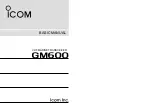
72
RocketIO™ Transceiver User Guide
UG024 (v3.0) February 22, 2007
Chapter 2:
Digital Design Considerations
R
Clock and Data Recovery
The clock/data recovery (CDR) circuits lock to the reference clock automatically if the data
is not present. For proper operation, TXUSRCLK must have the exact same frequency as
REFCLK. REFCLK, RXUSRCLK, and the incoming stream (RXRECCLK) must not exceed
±100 ppm of frequency variation.
It is critical to keep power supply noise low in order to minimize common and differential
noise modes into the clock/data recovery circuitry. See
, for more details.
Clock Correction
Clock RXRECCLK (the recovered clock) reflects the data rate of the incoming data. Clock
RXUSRCLK defines the rate at which the FPGA core consumes the data. Ideally, these rates
are identical. However, since the clocks typically have different sources, one of the clocks is
faster than the other. The receiver buffer accommodates this difference between the clock
rates. See
.
Nominally, the buffer is always half-full. This is shown in the top buffer, where the shaded
area represents buffered data not yet read. Received data is inserted via the write pointer
under control of RXRECCLK. The FPGA core reads data via the read pointer under control
of RXUSRCLK. The half-full/half-empty condition of the buffer gives a cushion for the
differing clock rates. This operation continues indefinitely, regardless of whether or not
“meaningful” data is being received. When there is no meaningful data to be received, the
incoming data consists of IDLE characters or other padding.
If RXUSRCLK is faster than RXRECCLK, the buffer becomes more empty over time. The
clock correction logic corrects for this by decrementing the read pointer to reread a
repeatable byte sequence. This is shown in the middle buffer,
, where the solid
read pointer decrements to the value represented by the dashed pointer. By decrementing
the read pointer instead of incrementing it in the usual fashion, the buffer is partially
refilled. The transceiver inserts a single repeatable byte sequence when necessary to refill a
buffer. If the byte sequence length is greater than one, and if attribute
CLK_COR_REPEAT_WAIT is 0, then the transceiver can repeat the same sequence
multiple times until the buffer is refilled to the half-full condition.
Figure 2-20:
Clock Correction in Receiver
Read
RXUSRCLK
Read
Read
Write
RXRECCLK
Write
Write
"Nominal" condition: buffer half-full
Buffer less than half -full (emptying)
Buffer more than half-full (filling up)
Repeatable sequence
Removable sequence
DS083-2_15_100901
Product Not Recommended for New Designs
















































